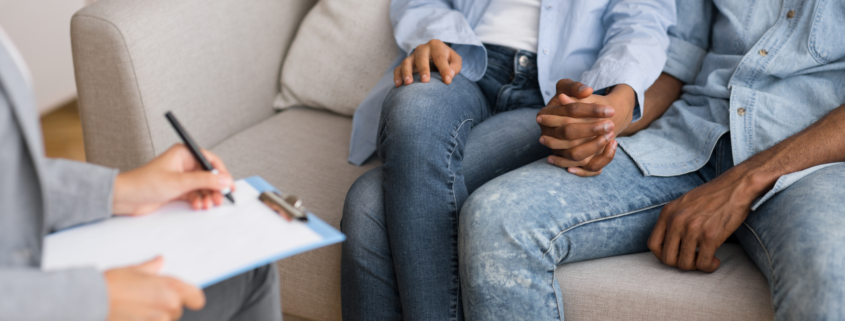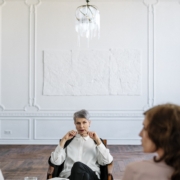Couples Therapy Techniques
Marriage counseling and couples therapy (we use the terms interchangeably) can have a hugely positive impact, with studies showing over 90% of couples finding it helpful. But there are so many different techniques that can be used in couples therapy, how do you know which one is the best fit for you? We’ve prepared this helpful guide to answer just that, breaking down some of the most popular and effective marriage counseling techniques below.
All of our therapists here at Well Marriage have studied these techniques, and more, extensively, as they’ve devoted their careers to helping couples specifically. We’ve gone in depth to make sure we know the most up to date practices and proven scientific approaches that help all interpersonal relationships, including how to handle vulnerability, complex pasts, and communication issues. Here are some of the techniques your therapist here might combine and engage in your unique and customized session.
What Is the Best Therapy for Relationship Problems?
The best therapy option for your relationship will depend on you and your partner’s life experiences, what your relationship challenges are, and the skill and expertise of your therapist. The best results from therapy will occur when both partners are willing and able to really commit to improving the relationship, and when evidence-based therapy techniques are used by a skilled therapist.
So can couples therapy help with your relationship? We think so! Our counselors use a variety of evidence-based techniques during sessions and will take you both through the couples therapy exercises that are most likely to be effective for you.
Some of the best supported techniques that will be incorporated include:
- The Gottman Method
- Developmental Model of Couples therapy
- Imago Therapy
- Emotionally Supported
- Behavioral Marital Therapy
What Is Gottman Method Couples Therapy?
John Gottman is a psychotherapist that has researched and published many studies on relationship theory, starting in the 1990’s. He has been listed as one of the most influential therapists of the last quarter century. His eponymously named Gottman couples therapy techniques also known as the “Gottman method” is well respected in the field.
So what is Gottman therapy? It is a technique that works to improve marriage functioning by avoiding behaviors found to hurt relationships. Gottman studied divorce and developed a successful divorce prediction method he called “The Four Horsemen,”– behaviors that herald the end of many relationships. These communication and conflict styles often flow into each other in unhealthy relationships, in what Gottman called the Cascade Model of Relational Dissolution. His four key predictors for divorce are:
- Criticism – Couples regularly turn conversations or normal complaints into personal attacks. Statements frequently begin with things like “You always…’ or “You never…”
- Defensiveness – Partners respond to frequent criticism with counter attacks or denial of their responsibility. This often leads to increased criticism and unproductive communication.
- Contempt (highest predictor of divorce) – Spouses lose respect for each other, and view themselves as far superior. This behavior can be seen as frequent mocking, hostility, cynicism and sarcasm.
- Stonewalling – Mates eventually shut down completely, withdrawing from communication and interaction. When conversation does occur, it’s usually unproductive and hostile.
The Gottman Method uses nine positive components to support couples in breaking these harmful methods of communication and conflict. These are called the “Sound Relationship House” and are meant to strengthen the core of a couple’s intimacy and understanding. They are:
- Love Maps – Ask questions designed for partners to get to know each other on a deeper level.
- Like Each Other More – Focus on this newfound understanding so the couple develops more fondness and admiration for each other.
- Turn Toward Each Other – Notice the other’s needs and bids for affection and try to respond to create more connection.
- Positive Perspective – Assume the best of your mate instead of criticizing.
- Conflict Management – Think about the other spouse’s feelings when issues arise and work toward more productive dialogue instead of fighting.
- Mutual Support – Work together to help each other reach life goals.
- Shared Meaning – Develop traditions as a couple that have significance to you both.
- Trust – Rely on each other as a source of strength.
- Commitment – Dedicate time and energy to the happiness of the relationship and each other.
What is the Developmental Model & What to Expect from Couples Therapy using the Developmental Model?
The developmental model of couples therapy was developed in the 1980’s and it focuses on the effects of development in relationships. The basic concept is that the individuals within a relationship progress through different developmental stages over time, similar to childhood developmental stages.
This theory predicts that most relationship conflicts happen when the two partners are in different developmental stages. Using this model, couple therapy questions can be used to tell which stage each partner is in at the time, so they can work towards the same developmental stage in the future.
These stages are:
- Bonding – when couples start to fall in love and crave closeness, the “honeymoon period”
- Differentiation – when partners discover their differences and learn to resolve conflict
- Practicing – when each person develops independence and their own interests outside of the relationship
- Rapprochement – when spouses return to each other after practicing independence
- Synergy – when both parties experience true intimacy and are stronger together than apart
Dr. Ellyn Bader has deepened our understanding of the Developmental Model in Couples Therapy through her research and training at the Couples Institute in San Francisco. All therapists at Well Marriage Center have completed her year-long “Developmental Model for Couples Therapy” training program. It focuses on attachment, differentiation (at its core, this is how emotionally mature we are as individuals), and recent advances in neuroscience. It’s a Gold Standard training program.
What Are Some Communication Exercises for Couples Using Imago Therapy?
Imago therapy builds on the idea that everyone’s childhood experiences shape who they are as adults, and that relationship issues can arise from these childhood happenings. So if a partner grew up in a house with a lot of criticism from a parent, they might be very sensitive to a partner’s criticism, or be very critical themselves.
We all understand that our childhood experiences affect our development, attachment styles, and how we communicate and approach conflict as an adult.
So how does Imago therapy help with couples therapy exercises for communication? There are several ways this therapy helps partners identify negative childhood experiences that have caused relationship breakdowns, then address these issues constructively. Some of these include:
- Go to a Happy Place – During a therapy session, parts of our brains are very reactive. Finding a mental space where an individual feels safe can make it easier for them to have a constructive session.
- Practice Mirrored Listening – When one spouse speaks, the other spouse can layer their own interpretation over what was actually said. Repeating what your partner says back to them, called mirroring, can show them that you heard what they really said and make it easier to create empathy. For example, during a heated discussion if one mate says “There are dirty dishes in the sink and it makes me mad”, the other could say “I hear you telling me that the dirty dishes made you angry.” Perhaps very simple, but practicing this can have benefits for all sorts of future conflict and resolution.
- See Your Partner as an Ally – Instead of viewing a current relationship as following the same negative patterns you’ve experienced in the past, look at it as a means for growth. Identify which part of the issue is about the here and now, and which part is about childhood concerns.
- Set Aside Time to Talk – Expressing your feelings is important in relationships, to avoid frustration and resentment. But expressing anger or sadness in the moment can be challenging. Imago therapy encourages a couple to make regular appointments to talk about their anger or other issues in a safe and controlled way. Giving time and space for both parties to be ready for this kind of conversation makes talks more productive for everyone.
Therapists may use this approach alone or, more typically, combined with other practices that help heal the complex divides that can spring up between individuals over time. Generally speaking, all models are combined by the therapist in some form or another that is catered to a couple’s unique situation.
What Are Some Couple Therapy Exercises Based on Emotionally Focused Therapy?
Emotionally focused therapy is built on the idea that someone’s emotions aren’t just responses to experiences, but are the basis for how humans structure their lives. This guiding principle is then used in couples therapy to rebuild or strengthen emotional bonds in couples first, which will then allow couples to constructively resolve their issues later.
Some good couple therapy exercises based on emotionally focused principles include:
- Slowing Down and Being Present – Making a conscious effort to pause in the routines of daily life to connect with your partner matters. This could look like pausing when you first get home to hug and kiss instead of immediately starting chores or vegging on your phone.
- Being Emotionally Engaged and Responsive – Showing your spouse that you are ready and able to have a real connection is key here. Uncross your arms and lean toward them while they share things about their day. When they reach for your hand, reach back and show them you are also ready for physical closeness.
- Creating Intentional Connection Times – Incorporating rituals as a couple around times and ways you connect is important to reinforce emotional bonding. Some common examples are greeting each other with a kiss when you wake up, setting aside a specific ‘date night’ to spend quality time together, or signing up for a joint activity you both enjoy.
Which Is an Example of Something Done in Behavioral Marital Therapy?
Behavioral marital therapy is a collective term for a variety of techniques that use the theory that actions reinforced are more likely to be repeated. The basis for behavioral couples therapy techniques is to have couples practice productive communication and provide positive reinforcement for good behavior. This is similar to cognitive behavioral therapy, but centers around relationships specifically.
For example, a couple might have frequent disagreements about who should do the dishes. In a behavioral marital therapy session, a therapist encourages them to discuss this problem using the positive communication styles they have been learning.
- Partner 1: “I get angry when I ask you to do the dishes and you never get around to it”.
- Therapist: Gently points out that there was criticism in this start to the conversation, and suggests that trying some validation and giving a specific example.
- Partner 1: “I know you are working really hard, doing an extra computer class in the evenings to support our family, and I appreciate it. But I need help with some of the housework sometimes too. It hurt me last night when you didn’t follow through when I asked you to help with the dishes.”
- Partner 2: “I know I got caught up in my work last night and didn’t do what you asked, and I’m sorry. I want to show you that I appreciate your time as well, and I’ll work harder to help with housework when you ask.”
Well Marriage: Evidence Based Techniques for Better Relationships
At Well Marriage, we know that every relationship is unique and deserves specialized attention. Our therapists all focus on relationships, which includes marriage and couples counseling, and stay up-to-date on the latest proven techniques. We have worked with over 15,000 couples in person or via video sessions and have the experience to help you and your partner fall in love all over again.
Our therapists often combine these, and other, techniques that is catered to help in a couple’s specific situation, no matter how trivial or tough it seems.
Please explore our website to see more of what we can offer you, then schedule an appointment with our intake coordinator Melinda to take the next step on your relationship journey.









